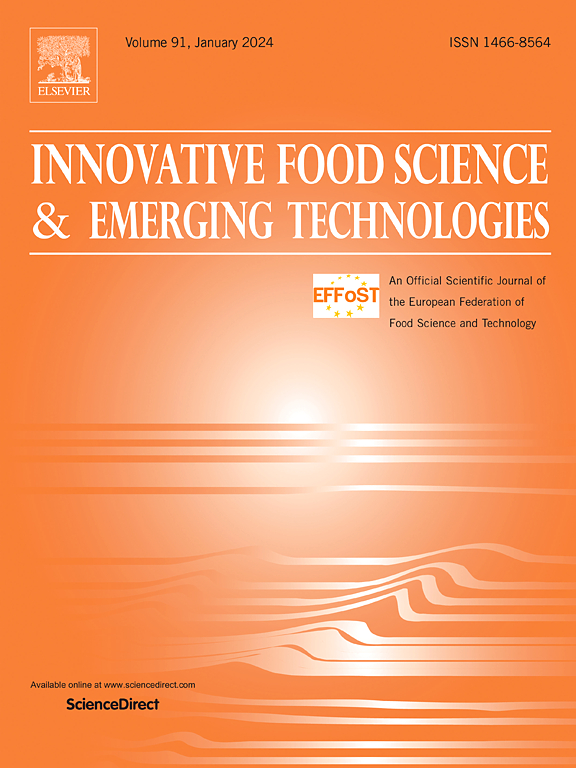Improving the edible quality of deacetylated konjac glucomannan gel: Synergistic ethanol immersion and low-temperature pretreatment
IF 6.8
1区 农林科学
Q1 FOOD SCIENCE & TECHNOLOGY
Innovative Food Science & Emerging Technologies
Pub Date : 2025-07-25
DOI:10.1016/j.ifset.2025.104130
引用次数: 0
Abstract
Solvent exchange approach and low-temperature treatment are both promising strategies that can be applied to improve hydrogel-based food quality. This study investigated the synergistic effect of different ethanol concentrations (15 % to 75 %) in combination with 4 °C refrigeration and − 20 °C freezing on the physical properties and edible attributes of deacetylated konjac glucomannan gel (DKG). The physical properties of DKG include hydration capacity, network strength, and pore size, while the edible attributes primarily include textural properties, chroma, pH, flavor profile, and sensory evaluation. Ethanol immersion and low-temperature treatment changed the water distribution and proportion, decreased pore size, and led to a more compact structure in DKG. Combined application of low concentration ethanol soaking (35 %) and freezing (−20 °C) effectively enhanced hardness and inhibits the dehydration shrinkage of DKG (inhibition rate = 71.34 %). Ethanol soaking and low-temperature treatment improved the DKG color, facilitated the absorption of flavor compounds, and enhanced consumer acceptance. Current results highlight the potential of ethanol synergized with low-temperature treatment as a simple and effective method to improve konjac edible quality and consumer appeal. Our findings provide insights into improving the physical properties of konjac hydrogel and offer a reference for expanding the practical application of konjac-based products.

提高脱乙酰魔芋葡甘露聚糖凝胶的食用品质:协同乙醇浸泡和低温预处理
溶剂交换法和低温处理都是改善水凝胶食品质量的有前途的策略。研究了不同浓度乙醇(15% ~ 75%)在4℃冷藏和- 20℃冷冻条件下对脱乙酰魔芋葡甘露聚糖凝胶(DKG)物理性能和食用特性的协同效应。DKG的物理特性包括水合能力、网络强度和孔径,而食用特性主要包括质地特性、色度、pH值、风味特征和感官评价。乙醇浸泡和低温处理改变了DKG的水分分布和比例,减小了孔隙大小,使DKG的结构更加致密。低浓度乙醇浸泡(35%)和冷冻(- 20℃)联合应用可有效提高DKG的硬度,抑制脱水收缩(抑制率为71.34%)。乙醇浸泡和低温处理改善了DKG的颜色,促进了风味化合物的吸收,提高了消费者的接受度。目前的研究结果表明,乙醇与低温处理的协同作用是提高魔芋食用品质和消费者吸引力的一种简单有效的方法。研究结果为改善魔芋水凝胶的物理性能提供了新的思路,为扩大魔芋制品的实际应用提供了参考。
本文章由计算机程序翻译,如有差异,请以英文原文为准。
求助全文
约1分钟内获得全文
求助全文
来源期刊
CiteScore
12.00
自引率
6.10%
发文量
259
审稿时长
25 days
期刊介绍:
Innovative Food Science and Emerging Technologies (IFSET) aims to provide the highest quality original contributions and few, mainly upon invitation, reviews on and highly innovative developments in food science and emerging food process technologies. The significance of the results either for the science community or for industrial R&D groups must be specified. Papers submitted must be of highest scientific quality and only those advancing current scientific knowledge and understanding or with technical relevance will be considered.

 求助内容:
求助内容: 应助结果提醒方式:
应助结果提醒方式:


